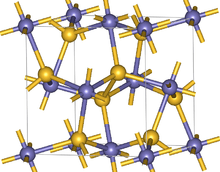Cobalt sulfide
Cobalt sulfide is the name for chemical compounds with a formula CoxSy. Well-characterized species include minerals with the formula CoS, CoS2, Co3S4, and Co9S8. In general, the sulfides of cobalt are black, semiconducting, insoluble in water, and nonstoichiometric.[1]
 | |
| Identifiers | |
|---|---|
PubChem CID |
|
| RTECS number |
|
| UNII | |
| Properties | |
| CoxSy | |
| Molar mass | 90.9982 g/mol |
| Appearance | black solid (alpha) grayish-red crystals (beta) |
| Density | 5.45 g/cm3 |
| Melting point | 1195 °C |
| 0.00038 g/100 mL (18 °C) | |
| Solubility | slightly soluble in acid |
| +225.0·10−6 cm3/mol | |
| Structure | |
| octahedral (beta) | |
Except where otherwise noted, data are given for materials in their standard state (at 25 °C [77 °F], 100 kPa). | |
| Infobox references | |
Minerals and hydrometallurgy
Cobalt sulfides occur widely as minerals, comprising major sources of all cobalt compounds. Binary cobalt sulfide minerals include the cattierite (CoS2) and linnaeite (Co3S4). CoS2 (see image in table) is isostructural with iron pyrite, featuring disulfide groups, i.e. Co2+S22−. Linnaeite, also rare, adopts the spinel motif.[2] The Co9S8 compound is known as a very rare cobaltpentlandite (the Co analogue of pentlandite).[3] Mixed metal sulfide minerals include carrollite (CuCo2S4) and siegenite (Co3−xNixS4).
Cobalt sulfide minerals are converted to cobalt via roasting and extraction into aqueous acid. In some processes, cobalt salts are purified by precipitation when aqueous solutions of cobalt(II) ions are treated with hydrogen sulfide. Not only is this reaction useful in the purification of cobalt from its ores, but also in qualitative inorganic analysis.[1]
Applications and research
In combination with molybdenum, the sulfides of cobalt are used as catalysts for the industrial process called hydrodesulfurization, which is implemented on a large scale in refineries. Synthetic cobalt sulfides are widely investigated as electrocatalysts.[4]
Selected literature
- Congiu, M.; Albano, L. G. S.; Decker, F.; Graeff, C. F. O. (2015-01-01). "Single precursor route to efficient cobalt sulphide counter electrodes for Dye-sensitized solar cells". Electrochimica Acta. 151: 517–524. doi:10.1016/j.electacta.2014.11.001.
- Huo, Jinghao; Zheng, Min; Tu, Yongguang; Wu, Jihuai; Hu, Linhua; Dai, Songyuan (2015-03-20). "A high performance cobalt sulfide counter electrode for dye-sensitized solar cells". Electrochimica Acta. 159: 166–173. doi:10.1016/j.electacta.2015.01.214.
- Congiu, M.; Albano, L. G. S.; Decker, F.; Graeff, C. F. O. (2015-01-01). "Single precursor route to efficient cobalt sulphide counter electrodes for dye sensitized solar cells". Electrochimica Acta. 151: 517–524. doi:10.1016/j.electacta.2014.11.001.
- Congiu, Mirko; Lanuti, Alessandro; di Carlo, Aldo; Graeff, Carlos F. O. (2015-12-01). "A novel and large area suitable water-based ink for the deposition of cobalt sulfide films for solar energy conversion with iodine-free electrolytes". Solar Energy. 122: 87–96. doi:10.1016/j.solener.2015.08.032. hdl:11449/177482.
- Lin, Jeng-Yu; Liao, Jen-Hung; Wei, Tzu-Chien (2011-04-01). "Honeycomb-like CoS Counter Electrodes for Transparent Dye-Sensitized Solar Cells". Electrochemical and Solid-State Letters. 14 (4): D41–D44. doi:10.1149/1.3533917. ISSN 1099-0062.
- Lin, Jeng-Yu; Liao, Jen-Hung; Chou, Shu-Wei (2011-10-01). "Cathodic electrodeposition of highly porous cobalt sulfide counter electrodes for dye-sensitized solar cells". Electrochimica Acta. 56 (24): 8818–8826. doi:10.1016/j.electacta.2011.07.080.
- Congiu, Mirko; Bonomo, Matteo; Marco, Maria Letizia De; Dowling, Denis P.; Di Carlo, Aldo; Dini, Danilo; Graeff, Carlos F. O. (2016-07-16). "Cobalt Sulfide as Counter Electrode in p-Type Dye-Sensitized Solar Cells". ChemistrySelect. 1 (11): 2808–2815. doi:10.1002/slct.201600297. ISSN 2365-6549.
- Nattestad, Andrew; Ferguson, Michael; Kerr, Robert; Cheng, Yi-Bing; Bach, Udo (2008). "Dye-sensitized nickel(II)oxide photocathodes for tandem solar cell applications". Nanotechnology. 19 (29): 295304. doi:10.1088/0957-4484/19/29/295304.
References
- John D. Donaldson, Detmar Beyersmann "Cobalt and Cobalt Compounds" in Ullmann's Encyclopedia of Industrial Chemistry 2005, Wiley-VCH, Weinheim. doi:10.1002/14356007.a07_281.pub2
- Greenwood, Norman N.; Earnshaw, Alan (1984). Chemistry of the Elements. Oxford: Pergamon Press. ISBN 978-0-08-022057-4.
- http://www.mindat.org
- Mathew, Simon; Yella, Aswani; Gao, Peng; Humphry-Baker, Robin; Curchod, Basile F. E.; Ashari-Astani, Negar; Tavernelli, Ivano; Rothlisberger, Ursula; Nazeeruddin, Md. Khaja (2014). "Dye-sensitized solar cells with 13% efficiency achieved through the molecular engineering of porphyrin sensitizers". Nature Chemistry. 6 (3): 242–247. doi:10.1038/nchem.1861. PMID 24557140.
- Cobalt sulfide, NIST Webbook